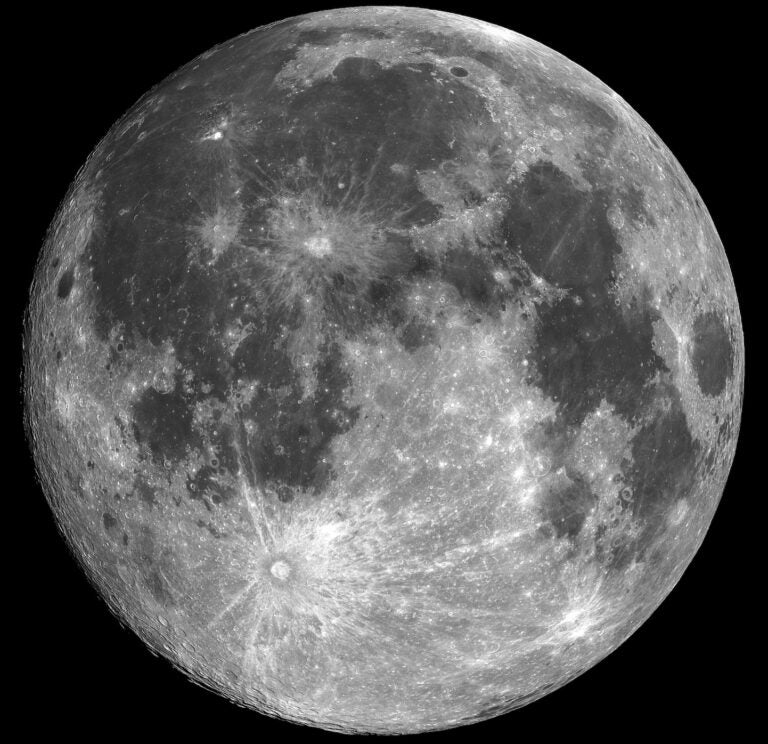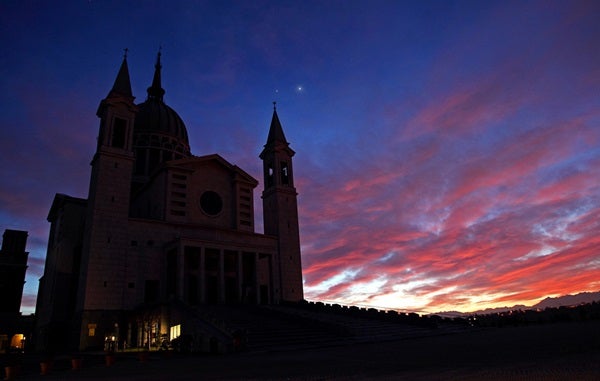

Venus (right) and Jupiter stood above the Basilica of Saint John Bosco in Castelnuovo Don Bosco (some 12 miles east of Turin, Italy) the evening of March 12, 2012. The two planets will appear even closer in mid-August.
Stefano de Rosa
The sky’s two brightest planets, Venus and Jupiter, put on a spectacular show in mid-August. Rarely do these luminaries come as close to each other in a nearly dark sky, which makes this predawn conjunction the month’s top celestial event. As a bonus, the pair lies next to the wonderful Beehive star cluster (M44).
The evening stage features a nice show starring two lesser lights. Mars passes Saturn in late August, an occasion that provides a striking color contrast in addition to the normally stunning views of the ringed planet through a telescope. The overnight hours belong to the distant ice giants, Uranus and Neptune. The latter planet reaches opposition and peak visibility this month, but both are easy to find through binoculars.
Our tour of the solar system starts low in evening twilight. Mercury passes behind the Sun from our viewpoint August 8 and then slowly climbs into view after sunset by month’s end. Your first opportunity to see it comes on the 27th when it lies 10° to the right of a waxing crescent Moon. From mid-northern latitudes, the two appear just 2° to 3° high in the west 30 minutes after sundown, so you’ll need a clear sky, an unobstructed horizon, and binoculars to see them. Mercury shines brightly at magnitude –0.4, which helps it pierce the twilight glow.
Mercury’s elongation from the Sun increases to 19° by the 31st, but its altitude barely budges. This is Mercury’s worst evening appearance of 2014 for Northern Hemisphere observers, and it won’t gain much altitude even by the time it reaches greatest elongation in late September. From south of the equator, however, skygazers will enjoy the inner world as it climbs high into a dark sky.
Mars and Saturn both lie in the southwestern sky as darkness falls during August. The Red Planet begins the month among the background stars of Virgo the Maiden, but it crosses the border into Libra the Balance on August 10.
Mars then lies 9° west of Saturn and is moving steadily closer. The two approach within 4° of each other by the 20th and remain within that distance until the 29th. Mars passes 3.6° due south of its partner on the 27th.
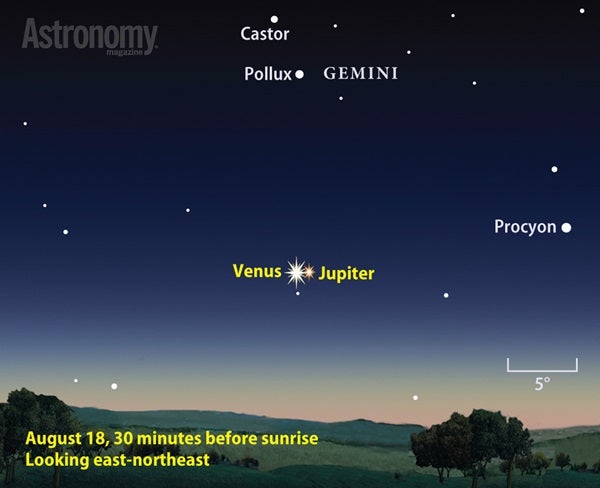
As Jupiter climbs higher in morning twilight this month, it passes a sinking Venus. The two planets appear just 0.2° apart before dawn August 18.
Astronomy: Roen Kelly
Throughout their close encounter, both planets shine at magnitude 0.6. They should appear equally intense, but the way your eye and brain perceive color could cause one to seem slightly brighter. At the very least, the color contrast should stand out. The sands of Mars display an orange-red hue while Saturn’s clouds glow yellowish.
Although the two start to separate by the end of August, don’t abandon them. On the evening of the 31st, the waxing crescent Moon forms a tight and elegant triangle with the planets. The trio sets around 10:30 p.m. local daylight time.
For observers in the southeastern United States, the Moon passes directly in front of Saturn on the afternoon of the 31st. This occultation occurs after darkness falls from West Africa.
Despite their similar brightnesses, Mars and Saturn couldn’t appear more different through a telescope. The Red Planet appears 7″ across this month and shows little detail in anything smaller than a 10-inch instrument. But Saturn measures a respectable 17″ across while the ring system spans 38″ and tilts 21° to our line of sight. Even the smallest scope will deliver exquisite views of the rings and the dark Cassini Division that separates the two brightest components.

Neptune shows up nicely through binoculars and telescopes in late August when it shines brightest (magnitude 7.8) against the backdrop of Aquarius.
Astronomy: Roen Kelly
Once Mars and Saturn set in late evening, the sky may seem devoid of planets. But looks can be deceiving — the next solar system denizen to appear doesn’t shout its presence. You will need binoculars or a telescope to spot Neptune, which glows at magnitude 7.8 against the backdrop of central Aquarius. The ice giant reaches the peak of its 2014 appearance at opposition August 29, when it rises at sunset and appears highest in the south around 1 a.m. local daylight time.
To locate Neptune, first zero in on the 5th-magnitude star Sigma (σ) Aquarii. The planet begins August 1.4° northeast of this star. Neptune moves steadily westward all month, however, and by opposition it is only about half as far away. Although binoculars gather enough light to show you the planet, the best way to confirm a sighting is to target it through a telescope. The ice giant world appears tiny but noticeably non-stellar in most scopes, sporting a 2.4″-diameter disk with a blue-gray color.
A nearly Full Moon passes near Neptune the night of August 11/12, effectively washing out the distant planet (and hindering views of the Perseid meteor shower’s peak the following night). But you may want to look at the Full Moon on the evening of the 10th because it’s the largest one of 2014. (For more details, see “The truth behind the Super Moon” on p. 64.)
You can find Uranus floating among the faint background stars of Pisces the Fish. The planet rises about 90 minutes after Neptune and reaches its peak in the south around the time morning twilight commences. Shining at magnitude 5.8, it appears bright enough to see with naked eyes under a dark sky, though binoculars make the task much easier. You’ll need a telescope to see its disk, which spans 3.6″ and sports a distinct blue-green color.
The easiest way to find Uranus is to first identify the 4th-magnitude star Epsilon (ε) Piscium. This distant sun lies 14° east-southeast of Algenib (Gamma [γ] Pegasi), the star at the southeastern corner of the Great Square of Pegasus. (Another way to find the correct location is to draw an imaginary line between the two brightest stars in Aries and extend it 18° to the southwest; the line points directly to Epsilon Psc.) As August opens, Uranus lies 2.2° south-southwest of Epsilon. The planet’s slow motion relative to the background carries it only 0.4° farther from Epsilon by month’s end.
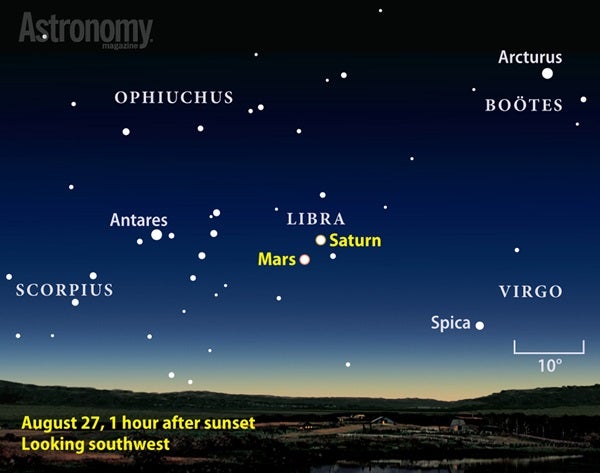
The Red Planet meets the ringed planet after darkness falls August 27, when the two 0.6-magnitude objects lie 4° apart.
Astronomy: Roen Kelly
The night sky saves its best for last. Venus and Jupiter have a dramatic meeting before dawn August 18, when they approach within 0.2° of each other with Cancer’s Beehive star cluster (M44) less than 1° away. But there’s no need to wait until the 18th to view the two brightest planets. Anticipate the upcoming conjunction by watching the two beacons in the days before as they dominate the east-northeastern sky.
A good day to start is August 12. Venus rises first, at 4:30 a.m. local daylight time, nearly 100 minutes before the Sun. Jupiter follows 30 minutes later and lies 5.8° to Venus’ lower left. Each morning thereafter, the two planets appear 1° closer. Do the math, and you’ll find that by August 17, they lie just 0.8° apart.
They come even closer on the 18th, when a mere 15′ (half of the Full Moon’s diameter) separate them for viewers in eastern North America. (The gap grows to 21′ from the West Coast.) Venus shines brighter (magnitude –3.8) than its companion (magnitude –1.8) and appears just to Jupiter’s left.
Through a telescope, both show up in the same field of view at low power. However, neither object will look great because of its low altitude. Venus sports a 10″-diameter disk that appears 95 percent lit, while Jupiter’s globe spans 32″ across the equator.
The pair also resides within 0.5° of the Beehive star cluster. The Beehive’s visibility will depend on atmospheric conditions and the steadily brightening sky. Nautical twilight, when the Sun is 12° below the horizon, begins an hour or so before sunrise; the objects then appear 5° high.
Although conjunctions of Jupiter and Venus occur fairly frequently, not many are as favorable as this one. Some take place too close to the Sun, and others feature a wider separation. The last encounter closer than this one happened May 17, 2000, but the planets were then only 7° from the Sun. The best close conjunction prior to this one took place the evening of February 23, 1999.
Following the conjunction, Jupiter lingers among the stars of Cancer while Venus crosses into Leo on August 26. A waning crescent Moon joins the two on the 23rd.
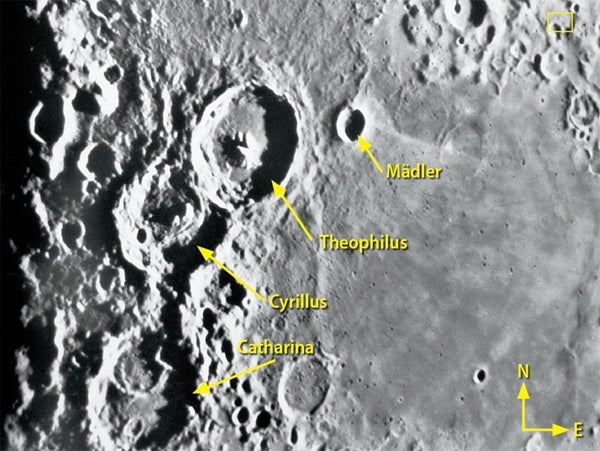
On August’s first evening, three similarly sized craters line up along the terminator of the waxing crescent Moon just south of the lunar equator.
Consolidated Lunar Atlas/UA/LPL
A TANTALIZING TRIO OF TERRIFIC CRATERS
The first days of August are a great time to view the crescent Moon in the western sky after sunset. As our satellite waxes from a slender arc to half-lit, a smorgasbord of sights awaits observers looking through telescopes of any size. The best area to explore is along the terminator, the zone between lunar day and night where the Sun is just rising. Each passing evening reveals new craters, many with towering central peaks surrounded by debris aprons.
Our focus this month is on August 1’s crescent. If you point your scope along the terminator just south of the lunar equator, three large craters — each about 60 miles in diameter — will grab your attention. Theophilus has a classic appearance: Its sharp rim describes a nearly perfect circle surrounding several dramatic central peaks. The crater’s walls have slumped into terraces that are most obvious on the western flank. Compare these walls with the relatively clean ones of Mädler, a smaller and shallower crater to Theophilus’ east.
You can make some good guesses at the relative ages of lunar features even without the tools of a geologist. Theophilus must be younger than its southwestern neighbor, Cyrillus, because it overlays the latter’s ragged rim. Cyrillus also has a complex central peak and slumped walls, but they have been degraded from longer exposure to small impacts.
Draped around Theophilus is an apron of debris ejected during the crater-forming impact. Although this ejecta partially fills Cyrillus, Mädler seems to shelter the terrain to its east, hinting at its intermediate age. The debris’ rough texture is obvious as the Sun rises over the region, but it vanishes under the high Sun at Full Moon.
The southernmost of our crater trio is Catharina. At one time, this structure was sharp-featured like Theophilus, but billions of years of bombardment have erased its central peak and left the walls softer and lower.
These lighting conditions almost repeat August 30. The Sun is then a little lower in the lunar sky, however, which exaggerates the apparent height of the features.
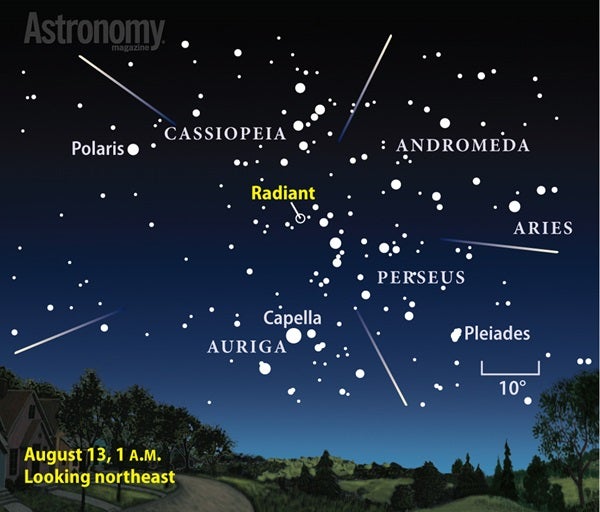
A bright Moon shares the sky with this year’s Perseid meteor shower, but viewers still could see a dozen or more “shooting stars” per hour.
Astronomy: Roen Kelly
MOONLIGHT RAINS ON THE PERSEID SHOWER
For most meteor observers, August’s warm nights and the abundant “shooting stars” from the Perseid meteor shower are the year’s highlight. Unfortunately, the Moon puts a damper on the 2014 event. The shower peaks the night of August 12/13, just two days after Full Moon. Bright moonlight will wash out fainter meteors and render the bright ones less impressive.
For the best view, wait until an hour before twilight begins August 13. Position yourself facing north, with the Moon to your rear and, if you can manage, behind a building or some trees.
| WHEN TO VIEW THE PLANETS | ||
| Evening Sky | Midnight | Morning Sky |
| Mercury (west) | Uranus (east) | Venus (east) |
| Mars (southwest) | Neptune (southeast) | Jupiter (east) |
| Saturn (southwest) | Uranus (south) | |
| Neptune (east) | Neptune (southwest) | |
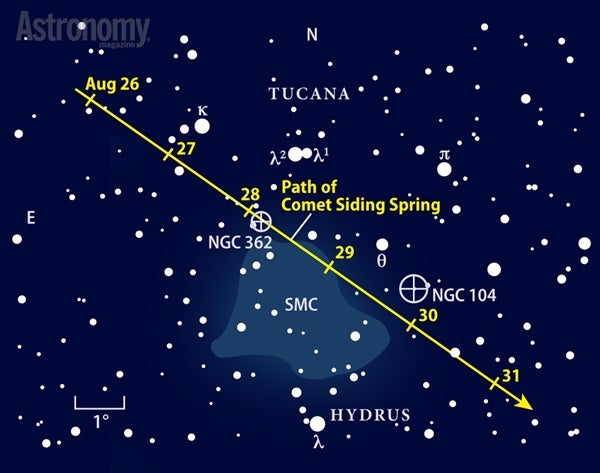
Observers south of the equator can watch an 8th-magnitude comet slide past the Small Magellanic Cloud (SMC) and globular cluster NGC 104.
Astronomy: Roen Kelly
A SOUTHERN HEMISPHERE DELIGHT
August’s sky features a few modest comets. But if you judge these dirty snowballs by the company they keep, the winner has to be Comet Siding Spring (C/2013 A1). This 8th-magnitude visitor zips past some great deep-sky objects, so, even though it resides deep in the southern sky, we couldn’t pass on the opportunity to alert our southern readers.
Australian astronomer Robert McNaught discovered this relic of the solar system’s birth in January 2013. It was a 19th-magnitude fuzzball at the time, so it has since brightened by more than 10,000 times. Still, you’ll need a telescope and a dark sky to get the best views of its trek through the inner solar system. The comet climbs highest after midnight, but it is so far south that it remains on view all night from locations throughout the Southern Hemisphere.
Siding Spring shares a low-power field of view with some amazing sights at month’s close. On the night of August 28/29, it practically covers the compact globular star cluster NGC 362. The cluster shines at magnitude 6.4, so it will appear noticeably brighter than the comet.
On the following night, Siding Spring slides along the flank of the Milky Way’s delightful satellite galaxy, the Small Magellanic Cloud (SMC). Trying to describe the SMC to northerners is like explaining the Rockies or the Alps to someone who’s never seen real mountains before. To top it all off, the comet nearly grazes the outer edge of the enormous globular star cluster 47 Tucanae (NGC 104) the night of August 30/31. This 4th-magnitude globular makes M13 in Hercules look small and dim.
Although only southerners can enjoy Siding Spring this month, the rest of us can snag a view of it in mid-October when the comet skims past Mars.
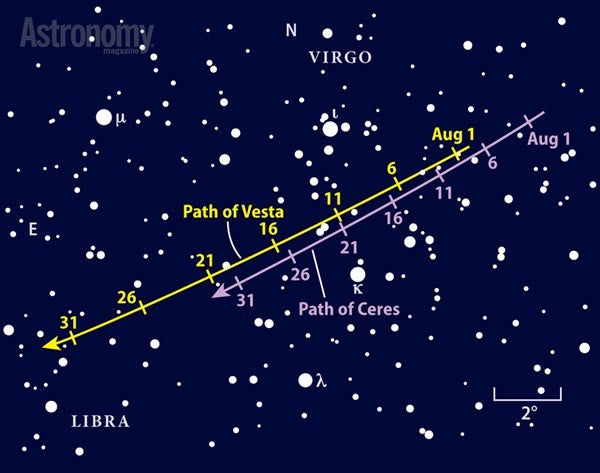
Ceres and Vesta remain within 5° of each other throughout August as they cross from Virgo the Maiden into Libra the Balance.
Astronomy: Roen Kelly
VESTA AND CERES SLOWLY DRIFT APART
One month after their closest approach, asteroids 1 Ceres and 4 Vesta continue as the targets of choice. Not only are they the two brightest (Vesta glows at magnitude 7.6 and Ceres at magnitude 8.9 at midmonth), but they also remain a stone’s throw apart. Both show up easily through small telescopes from the suburbs, and Vesta appears through binoculars.
The pair conveniently resides some 10° above Mars and Spica in the southwestern sky as darkness settles in. Skip the first few nights of August when the waxing Moon passes near. The field of stars between 4th-magnitude Iota (ι) and Kappa (κ) Virginis make a nice framework for locating the pair around mid-August.
The thrill of observing asteroids often comes from appreciating their movement relative to background stars that stay pretty static during a human lifetime. The closer an object orbits the Sun, the faster it wheels around the solar system. Generally, this translates into a greater shift in position from night to night. Notice on the chart below and in the heavens above how much faster Vesta moves in August compared with more distant Ceres.
Martin Ratcliffe provides planetarium development for Sky-Skan, Inc. from his home in Wichita, Kansas. Meteorologist Alister Ling works for Environment Canada in Edmonton, Alberta.









